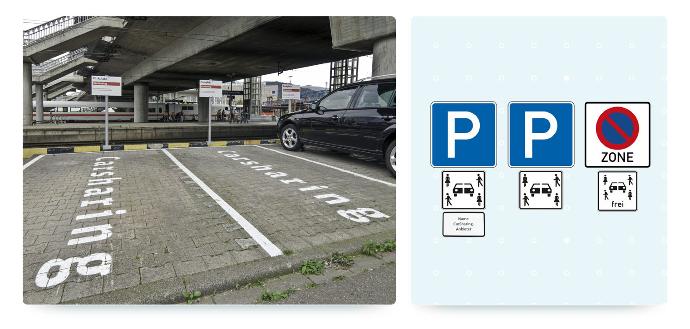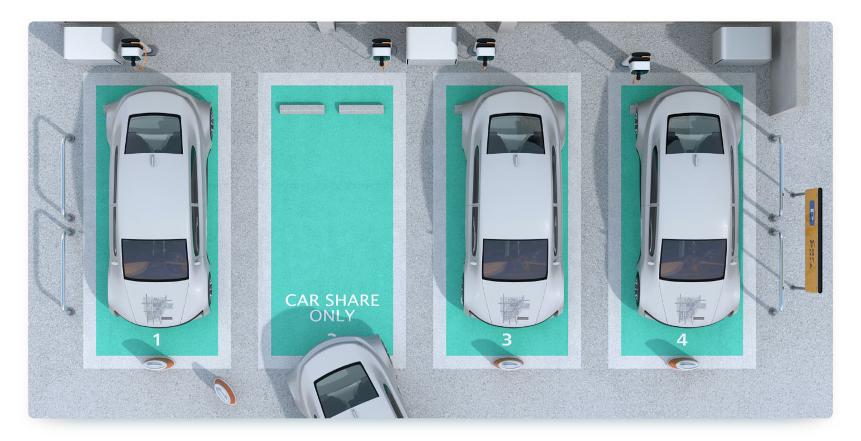Station-based sharing models play a decisive role even in cities. They have the advantage that they are predictable and reliable for users. But where do you, as a provider, place the vehicles in a sensible way? After all, the choice of stations is an important factor for success.
What's Important For Your Customers
In principle, both proximity to a residential area and location at important transportation hubs such as train stations or bus stops are recommended. After all, your customers must be willing to pick up the vehicle at the location you have chosen.
In order to be able to compete with private cars, carsharing cars are located within walking distance and ideally no more than 400 meters from the place of residence. This makes it more likely that people will do without their own vehicles.
In addition, a link with transport hubs and public transport makes sense. This is particularly relevant for micromobility, i.e., bikes and scooters. These are often used to bridge the so-called "last mile". In addition, the public visibility of your brand at the vehicles or stations there attracts attention and has a positive effect on your awareness as a provider.
Other major focal points in the city also make good stations, for example, shopping centers, universities and colleges, major corporate locations, etc.

Relevant Criteria For You as a Provider
Of course, you also have your own interests that you may include in the choice of location. After all, whether you can reach the vehicles quickly, for example to keep an eye on the general condition and cleanliness, affects time and costs.
In most cases, however, it is not even necessary for you to inspect the vehicles on a daily basis. Tools for assessing cleanliness or reporting damage in the sharing app help you stay informed regardless of location.
In any case, you can also use external service providers for vehicle-related tasks. Or you can use local partners at the parking spaces. Perhaps your cars, bikes or scooters are parked in front of a café or a store whose operators are motivated to cooperate with you and take care of the vehicles. In return, you can offer discounted rates.
Whether you still want the vehicles to be located directly at your company site is up to you. One advantage of this is that the connection between the vehicles and your company is obvious. On the other hand, your company location may not meet the needs of your customers regarding a location.
Analyze the mobility potential of a city
For making well informed decisions you might want to use a tool to analyze the mobility in a certain city. One example for that is the accessibility score by PTV Group.
The tool gives you detailed information about mobility around your city and it shows you how accessible everyday destinations are with different types of transportation (walking, cycling, public transport, car).
The Role of Local Authorities in Site Selection
In principle, you have three options for setting up parking spaces:
1) On your own property
2) Lease of private land or underground parking
3) Use of parking spaces in public areas after approval
Perhaps you are now wondering how you can implement the third option in particular? That depends on your municipality.
In Germany, you must go through your local government's allocation process. Municipalities can designate general parking spaces for carsharing, issue parking permits for residents' parking spaces and parking management zones, as well as reduce or completely waive parking fees in public spaces for carsharing vehicles. In addition, they can also allocate individual parking spaces to a specific provider with the help of a special use permit.
It is important to know that you usually have to participate in a public selection procedure. A simplified allocation of parking spaces occurs in small municipalities or when there are enough free spaces.
The parking spaces are selected by the municipalities and are based on proximity to public transport stops, residential areas or other strategic locations, as well as the general parking pressure in the city.
Knowledge for Take Away
Our guide will help you stay on top of things as you build your sharing offering. Learn what matters and what you should think about.
In most cases, not all parking spaces are allocated at the same time, but on a staggered basis. The maximum special use period is 8 years. In order to keep the economic risk for providers manageable, municipalities are recommended to make use of this maximum period. As compensation for the economic advantage and the impairment of the general public's use of the space, you pay a monthly special use fee to the municipality as a beneficiary provider.

Tips for Designing the Parking Spaces
Invest in the design of your parking spots. Use your brand colors and place your logo prominently. For example, put up a sign or place a marker on the ground. Prominent stations attract a lot of attention, especially in high-traffic locations such as train stations, and can increase your brand awareness.
To limit the risk of other people's vehicles being mistakenly parked in your parking spaces, consider barrier measures. This could be a fence, folding bollards or similar. If you decide to do this, inform your customers to fold up the bollard or close the gate after parking, thus blocking the parking space for others. However, make sure that customers still have easy access to the vehicle despite all precautions.
Parking spaces in public areas are usually marked with official signs. There are different signs for general parking spaces that can be used by different carsharing providers and assigned parking spaces. Also, if carsharing vehicles are allowed to park in resident parking zones, this will be signposted accordingly. If applicable, affix a sticker to the windshield in the car that identifies the car as a carsharing vehicle.

What About Free-floating Services?
If you have opted for a free-floating offer, you do not have to decide on a permanent location. In fact, it is not up to you where users park their vehicles within the parking zone at the end of a trip. This is exactly why you should strive for a regular, strategically sensible redistribution.
Also with free-floating, your vehicles should be located where users can find them or where they are willing to pick them up. Small side streets or dark backyards may be part of the business area, but may prevent some of your customers from picking up their vehicles, especially in the evening. Get to know typical routes of your users and find the optimal distribution of your vehicles.
It All Depends On the Needs of Your Customers
Don't be put off by intensive research and analysis on the subject of site selection. Where your vehicles are located ultimately determines how often they are booked. That's why the wishes and requirements of potential drivers come first when choosing suitable locations.
However, you should also consider criteria such as accessibility for you as a provider or for external service providers as well as the costs of a parking space. Only if the benefits and costs are in balance will the locations contribute to the profitability of your sharing service.




